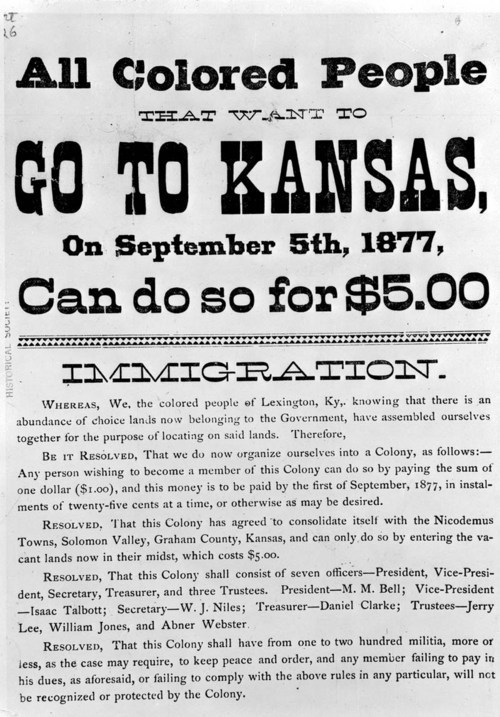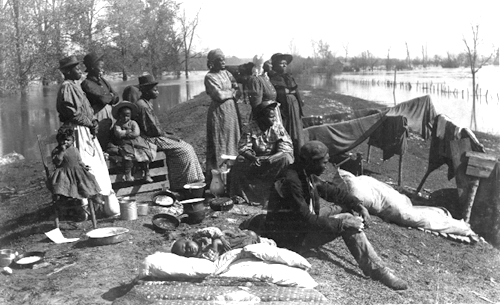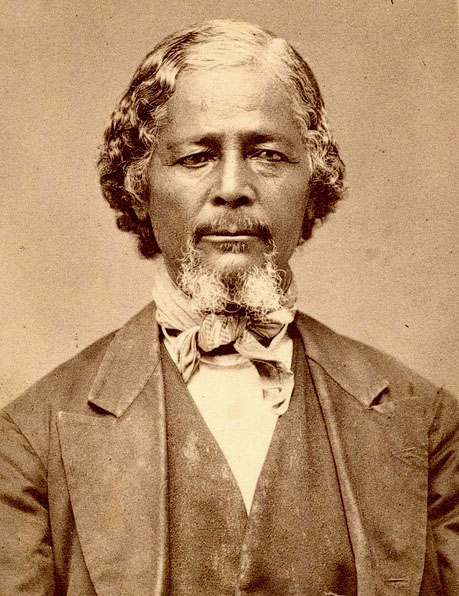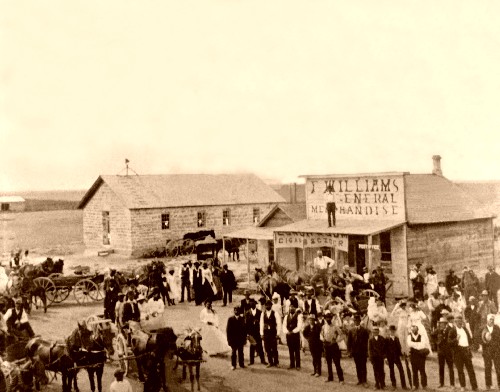
Good Morning POU!
This week we will explore the history and significance of The Exodusters Movement.
Exodusters waiting for a steamboat to carry them westward in the late 1870’s.

Exodusters was a name given to African Americans who migrated from states along the Mississippi River to primarily Kansas, as well as other surrounding states in the late nineteenth century, as part of the Exoduster Movement or Exodus of 1879. It was the first general migration of blacks following the Civil War. The movement received substantial organizational support from prominent figures, Benjamin Singleton of Tennessee and Henry Adams of Louisiana. As many as forty thousand Exodusters left the South to settle in Kansas, Oklahoma and Colorado.
In 1879, an African-American man from Louisiana wrote a letter to the governor of Kansas that read in part: “I am very anxious to reach your state, not just because of the great race now made for it but because of the sacredness of her soil washed by the blood of humanitarians for the cause of black freedom.”
This man was not alone. Thousands of African-Americans made their way to Kansas and other Western states after Reconstruction. The Homestead Act and other liberal land laws offered blacks (in theory) the opportunity to escape the racism and oppression of the post-war South and become owners of their own tracts of private farmland. For people who had spent their lives working the lands of white masters with no freedom or pay, the opportunities offered by these land laws must have seemed the answer to prayer. Many individuals and families were indeed willing to leave the only place they had known to move to a place few of them had ever seen. The large-scale black migration from the South to Kansas came to be known as the “Great Exodus,” and those participating in it were called “exodusters.” The name comes from the exodus from Egypt during Biblical times. Most Exodusters arrived by steamboats landing in the river cities of Wyandotte, Atchison, and Kansas City.
Benjamin “Pap” Singleton
Father of the African American exodus. Born: 1809, Nashville, Tennessee. Died: February 17, 1900, in Kansas City, Missouri.
He was born a slave in 1809, but after 37 years of bondage Benjamin Singleton escaped to freedom. He made Detroit his home and operated a secret boardinghouse for other escaped slaves. Following emancipation, Singleton returned to his native Tennessee.
After the Civil War, African Americans in the South enjoyed the rights and privileges of American citizenship. But when the federal troops were removed, their rights were no longer secure. The Ku Klux Klan emerged to strike terror and death to Blacks who refused to submit to their will. A sharecropping system virtually re-enslaved Black tenant farmers.
Because Kansas was famous for John Brown’s efforts and its struggle against slavery, Singleton considered the state a new Canaan, and he, like a “Black Moses,” would lead his people to the promised land. Singleton traveled through the South organizing parties to colonize in Kansas. Singleton distributed promotional posters and handbills which touted “Sunny Kansas” as “one of the finest countries for a poor man in the world,” with “plenty of stone and water, and wood on the streams.” One poster described, “large tracts of land, peaceful homes and firesides, undisturbed by any one.”
Between 1877 and 1879 nearly 300 African Americans followed him to Kansas. Some lived in “Singleton’s Colony” in Cherokee County. Others settled in Wyandotte, in Topeka’s Tennessee Town, and in Dunlap Colony near present Emporia. Singleton advocated the organized colonization of blacks in communities like Nicodemus, first settled in 1877.
A second wave of nearly 20,000 African Americans came to Kansas in 1879 and 1880. Unlike the first groups of immigrants that had resources and arrived in smaller organized groups, these “Exodusters” had no money and they arrived daily by the hundreds. They had often traveled through areas riddled by Yellow Fever. These people, often arriving sick with the fever, were not prepared to begin a new life. Most came with little if any money. The cities were overwhelmed with the large number of needy persons. Shelter and food had to be provided.
The communities in which they tried to settle were already struggling economically and were not prepared for such a spike in population. The communities appealed to the state government for assistance, resulting in the creation of the Kansas Freedmen’s Relief Association in 1879. The mission of the KFRA was to collect and distribute resources for struggling African Americans in Kansas. Though many African Americans came unprepared, most who remained were able to improve the quality of their lives and made important contributions to the state and the communities in which they lived.
In 1855 the Kansas Territory census showed 151 free blacks and 192 slaves living in the territory. Freed from slavery many began to come to Kansas during the 1860s and 1870s. In 1870 there were 17,108 blacks in the state. By 1880 the number of blacks living in Kansas had increased to 43,107.
Known affectionately as “Pap,” Benjamin Singleton died in 1900. Through his last years he took great comfort and pride in the role in played as “Father of the Negro Exodus.”
Short documentary exploring the village of Nicodemus, Kansas, the first and only remaining exoduster town founded by freed black slaves after the Civil War.



